Nonlinear Trend and Multiscale Variability of Dry Spells in Senegal (1951–2010)
Abstract
1. Introduction
2. Materials and Methods
2.1. Study Area
2.2. Data
2.3. Methods
2.3.1. Dry Spell Computation
2.3.2. Improved Complete Ensemble Empirical Mode Decomposition with Adaptive Noise (ICEEMDAN)
2.3.3. Significance Test of IMF and Trend Components
2.3.4. Variance Contribution Rate
2.3.5. Spatial Evolution of ICEEMDAN Trend
2.3.6. Rescaled Range (R/S) Analysis
2.3.7. Lacunarity Method
3. Results and Discussion
3.1. Spatial Distribution of AMDSLs
3.2. Multiscale Decomposition of AMDSLs Using ICEEMDAN
3.3. Long-Term Memory in AMDSLs
3.4. Lacunarity Analysis of AMDSLs
4. Conclusions
Author Contributions
Funding
Institutional Review Board Statement
Informed Consent Statement
Data Availability Statement
Acknowledgments
Conflicts of Interest
References
- IPCC. Summary for Policymakers. In Climate Change 2021: The Physical Science Basis. Contribution of Working Group I to the Sixth Assessment Report of the Intergovernmental Panel on Climate Change; Masson-Delmotte, V., Zhai, P., Pirani, A., Connors, S.L., Péan, C., Berger, S., Caud, N., Chen, Y., Goldfarb, L., Gomis, M.I., et al., Eds.; Cambridge University Press: Cambridge, UK, 2021; Volume 2021, pp. 3–32. [Google Scholar]
- Boko, M.; Niang, I.; Nyong, A.; Vogel, C.; Githeko, A.; Medany, M.; Osman-Elasha, B.; Tabo, R.; Yanda, P. Africa Climate Change 2007: Impacts, Adaptation and Vulnerability. In Contribution of Working Group II to the Fourth Assessment Report of the Intergovernmental Panel on Climate Change; Parry, M.L., Canziani, O.F., Palutikof, J.P., van der Linden, P.J., Hanson, C.E., Eds.; Cambridge University Press: Cambridge, UK, 2007; pp. 433–467. [Google Scholar]
- Parry, M.L.; Canziani, O.F.; Palutikof, J.P.; van der Linden, P.J.; Hanson, C.E. Climate Change: Impacts, Adaptation and Vulnerability. In Contribution of Working Group II to the Fourth Assessment Report of the Intergovernmental Panel on Climate Change; Cambridge University Press: Cambridge, UK, 2007; p. 976. [Google Scholar]
- Sylla, M.B.; Giorgi, F.; Coppola, E.; Mariotti, L. Uncertainties in daily rainfall over Africa: Assessment of gridded observation products and evaluation of a regional climate model simulation. Int. J. Clim. 2012, 33, 1805–1817. [Google Scholar] [CrossRef]
- Lobell, D.B.; Bänziger, M.; Magorokosho, C.; Vivek, B. Nonlinear heat effects on African maize as evidenced by historical yield trials. Nat. Clim. Chang. 2011, 1, 42–45. [Google Scholar] [CrossRef]
- Druyan, L.M. Studies of 21st-century precipitation trends over West Africa. Int. J. Clim. 2010, 31, 1415–1424. [Google Scholar] [CrossRef]
- Anyamba, A.; Small, J.L.; Britch, S.C.; Tucker, C.J.; Pak, E.W.; Reynolds, C.A.; Crutchfield, J.; Linthicum, K.J. Recent Weather Extremes and Impacts on Agricultural Production and Vector-Borne Disease Outbreak Patterns. PLoS ONE 2014, 9, e92538. [Google Scholar] [CrossRef] [PubMed]
- Sylla, M.B.; Elguindi, N.; Giorgi, F.; Wisser, D. Projected robust shift of climate zones over West Africa in response to anthro-pogenic climate change for the late 21st century. Clim. Chang. 2016, 134, 241–253. [Google Scholar] [CrossRef]
- Jenkins, G.S.; Gaye, A.T.; Sylla, B. Late 20th century attribution of drying trends in the Sahel from the Regional Climate Model (RegCM3). Geophys. Res. Lett. 2005, 32, L22705. [Google Scholar] [CrossRef]
- Tall, M.; Sylla, B.M.; Dajuma, A.; Koubodana, H.D.; Klutse, N.A.B.; Dosio, A.; Lennard, C.; Driouech, F.; Diedhiou, A.; Giorgi, F. Drought variability, changes and hot spots across the African continent during the historical period (1928–2017). Int. J. Climatol. 2023, under review. [Google Scholar]
- World Food Programme. WFP Senegal Country Brief 2018; World Food Programme: Rome, Italy, 2018. [Google Scholar]
- Le Barbé, L.; Lebel, T.; Tapsoba, D. Rainfall Variability in West Africa during the Years 1950–90. J. Clim. 2002, 15, 187–202. [Google Scholar] [CrossRef]
- Lebel, T.; Ali, A. Recent trends in the central and western sahel rainfall regime (1990–2007). J. Hydrol. 2009, 375, 52–64. [Google Scholar] [CrossRef]
- Nicholson, S.E. The West African Sahel: A Review of Recent Studies on the Rainfall Regime and Its Interannual Variability. ISRN Meteorol. 2013, 2013, 453521. [Google Scholar] [CrossRef]
- Dione, C.; Lothon, M.; Badiane, D.; Campistron, B.; Couvreux, F.; Guichard, F.; Sall, S.M. Phenomenology of Sahelian convection observed in Niamey during the early monsoon. Q. J. R. Meteorol. Soc. 2013, 140, 500–516. [Google Scholar] [CrossRef]
- Yeni, F.; Alpas, H. Vulnerability of global food production to extreme climatic events. Food Res. Int. 2017, 96, 27–39. [Google Scholar] [CrossRef] [PubMed]
- Fall, C.M.N.; Lavaysse, C.; Drame, M.S.; Panthou, G.; Gaye, A.T. Wet and dry spells in Senegal: Evaluation of satellite-based and model re-analysis rainfall estimates. Nat. Hazards Earth Syst. Sci. 2019, 21, 1051–1069. [Google Scholar] [CrossRef]
- Washington, R.; Harrison, M.; Conway, D.; Black, E.; Challinor, A.; Grimes, D.; Jones, R.; Morse, A.; Kay, G.; Todd, M. African Climate Change: Taking the Shorter Route. Bull. Am. Meteorol. Soc. 2006, 87, 1355–1366. [Google Scholar] [CrossRef]
- Sane, Y.; Panthou, G.; Bodian, A.; Vischel, T.; Lebel, T.; Dacosta, H.; Quantin, G.; Wilcox, C.; Ndiaye, O.; Diongue-Niang, A.; et al. Intensity–duration–frequency (IDF) rainfall curves in Senegal. Nat. Hazards Earth Syst. Sci. 2018, 18, 1849–1866. [Google Scholar] [CrossRef]
- Nicholson, S.E.; Fink, A.H.; Funk, C. Assessing recovery and change in West Africa’s rainfall regime from a 161-year record. Int. J. Clim. 2018, 38, 3770–3786. [Google Scholar] [CrossRef]
- Fall, C.M.N.; Lavaysse, C.; Drame, M.S.; Panthou, G.; Gaye, A.T. Wet and dry spells in Senegal: Comparison of detection based on satellite products, reanalysis, and in situ estimates. Nat. Hazards Earth Syst. Sci. 2021, 21, 1051–1069. [Google Scholar] [CrossRef]
- Fall, C.M.N.; Lavaysse, C.; Kerdiles, H.; Dramé, M.S.; Roudier, P.; Gaye, A.T. Performance of dry and wet spells combined with remote sensing indicators for crop yield prediction in Senegal. Clim. Risk Manag. 2021, 33, 100331. [Google Scholar] [CrossRef]
- Salack, S.; Klein, C.; Giannini, A.; Sarr, B.; Worou, O.N.; Belko, N.; Bliefernicht, J.; Kunstman, H. Global warming induced hybrid rainy seasons in the Sahel. Environ. Res. Lett. 2016, 11, 104008. [Google Scholar] [CrossRef]
- Froidurot, S.; Diedhiou, A. Characteristics of wet and dry spells in the West African monsoon system. Atmos. Sci. Lett. 2017, 18, 125–131. [Google Scholar] [CrossRef]
- Salack, S.; Giannini, A.; Diakhaté, M.; Gaye, A.T.; Muller, B. Oceanic influence on the sub-seasonal to interannual timing and frequency of extreme dry spells over the West African Sahel. Clim. Dyn. 2013, 42, 189–201. [Google Scholar] [CrossRef]
- de Carvalho, J.R.P.; Assad, E.D.; Evangelista, S.R.M.; Pinto, H.d.S. Estimation of dry spells in three Brazilian regions—Analysis of extremes. Atmos. Res. 2013, 132–133, 12–21. [Google Scholar] [CrossRef]
- Dieng, O.; Roucou, P.; Louvet, S. Variabilité intra-saisonnière des précipitations au sénégal (1951–1996). Sécheresse 2008, 19, 87–93. [Google Scholar]
- Osorio, J.G.; Galiano, S.G. Non-stationary analysis of dry spells in monsoon season of Senegal River Basin using data from Regional Climate Models (RCMs). J. Hydrol. 2012, 450–451, 82–92. [Google Scholar] [CrossRef]
- Touré, A.K.; Fall, C.M.N.; Diakhaté, M.; Wane, D.; Rodríguez-Fonseca, B.; Ndiaye, O.; Diop, M.; Gaye, A.T. Predictability of Intra-Seasonal Descriptors of Rainy Season over Senegal Using Global SST Patterns. Atmosphere 2022, 13, 1437. [Google Scholar] [CrossRef]
- Ndiaye, B.; Moussa, M.A.; Wade, M.; Sy, A.; Diop, A.B.; Diop, A.D.; Diop, B.; Diakhaby, A. Spatial and Temporal Distribution of Rainfall Breaks in Senegal. Am. J. Clim. Chang. 2021, 10, 533–560. [Google Scholar] [CrossRef]
- Lorenzelli, F. The Essence of Chaos; CRC Press: Boca Raton, FL, USA, 2014. [Google Scholar]
- Tang, W.; Zhou, F.; Mei, Z.; Dong, Z.; Bai, M. The Characteristics of Nonlinear Trends and the Complexity of Hydroclimatic Change in China from 1951 to 2014. Atmosphere 2022, 13, 1583. [Google Scholar] [CrossRef]
- Xu, J.; Chen, Y.; Li, W.; Dong, S. Long-term trend and fractal of annual runoff process in mainstream of Tarim River. Chin. Geogr. Sci. 2008, 18, 77–84. [Google Scholar] [CrossRef]
- Xu, J.; Chen, Y.; Li, W.; Liu, Z.; Wei, C.; Tang, J. Understanding the Complexity of Temperature Dynamics in Xinjiang, China, from Multitemporal Scale and Spatial Perspectives. Sci. World J. 2013, 2013, 259248. [Google Scholar] [CrossRef]
- Liu, Z.; Xu, J.; Shi, K. Self-organized criticality of climate change. Theor. Appl. Clim. 2013, 115, 685–691. [Google Scholar] [CrossRef]
- Xu, J.; Chen, Y.; Li, W.; Liu, Z.; Tang, J.; Wei, C. Understanding temporal and spatial complexity of precipitation distribution in Xinjiang, China. Theor. Appl. Clim. 2015, 123, 321–333. [Google Scholar] [CrossRef]
- Martínez, M.D.; Lana, X.; Burgueño, A.; Serra, C. Lacunarity, predictability and predictive instability of the daily pluviometric regime in the Iberian Peninsula. Nonlinear Process. Geophys. 2007, 14, 109–121. [Google Scholar] [CrossRef][Green Version]
- Lana, X.; Martínez, M.D.; Serra, C.; Burgueño, A. Complex behavior and predictability of the European dry spell regimes. Nonlin. Process Geophys. 2010, 17, 499–512. [Google Scholar] [CrossRef]
- Lana, X.; Martínez, M.D.; Burgueño, A.; Serra, C.; Martín-Vide, J.; Gomez, L. Multifractality and autoregressive processes of dry spell lengths in Europe: An approach to their complexity and predictability. Theor. Appl. Clim. 2015, 127, 285–303. [Google Scholar] [CrossRef]
- Fall, S.; Niyogi, D.; Semazzi, F.H.M. Analysis of Mean Climate Conditions in Senegal (1971–98). Earth Interact. 2006, 10, 1–40. [Google Scholar] [CrossRef]
- Salack, S.; Muller, B.; Gaye, A.T. Rain-based factors of high agricultural impacts over Senegal. Part I: Integration of local to sub-regional trends and variability. Theor. Appl. Clim. 2011, 106, 1–22. [Google Scholar] [CrossRef]
- Roudier, P.; Muller, B.; D’aquino, P.; Roncoli, C.; Soumaré, M.; Batté, L.; Sultan, B. The role of climate forecasts in smallholder agriculture: Lessons from participatory research in two communities in Senegal. Clim. Risk Manag. 2014, 2, 42–55. [Google Scholar] [CrossRef]
- Sarr, M.; Moussa, M.A.; Deme, E.H.; Diop, B. Trend and Return Level Analysis of Extreme Rainfalls in Senegal. J. Water Resour. Prot. 2022, 14, 221–237. [Google Scholar] [CrossRef]
- Diallo, I.; Giorgi, F.; Deme, A.; Tall, M.; Mariotti, L.; Gaye, A. Projected changes of summer monsoon extremes and hy-droclimatic regimes over West Africa for the twenty-first century. Clim. Dyn. 2016, 47, 3931–3954. [Google Scholar] [CrossRef]
- Wu, Z.; Huang, N.E.; Wallace, J.M.; Smoliak, B.V.; Chen, X. On the time-varying trend in global-mean surface temperature. Clim. Dyn. 2011, 37, 759–773. [Google Scholar] [CrossRef]
- Sang, Y.-F.; Wang, Z.; Liu, C. Period identification in hydrologic time series using empirical mode decomposition and maximum entropy spectral analysis. J. Hydrol. 2012, 424–425, 154–164. [Google Scholar] [CrossRef]
- Kuo, C.C.; Gan, T.Y.; Chan, S. Regional intensity-duration-frequency curves derived from ensemble empirical mode decom-position and scaling property. J. Hydrol. Eng. 2013, 18, 66–74. [Google Scholar] [CrossRef]
- Qian, C.; Zhou, T. Multidecadal Variability of North China Aridity and Its Relationship to PDO during 1900–2010. J. Clim. 2014, 27, 1210–1222. [Google Scholar] [CrossRef]
- Antico, A.; Schlotthauer, G.; Torres, M.E. Analysis of hydroclimatic variability and trends using a novel empirical mode de-composition: Application to Parana river basin. J. Geophy. Res: Atmos. 2014, 119, 1218–1233. [Google Scholar] [CrossRef]
- Bai, L.; Xu, J.; Chen, Z.; Li, W.; Liu, Z.; Zhao, B.; Wang, Z. The regional features of temperature variation trends over Xinjiang in China by the ensemble empirical mode decomposition method. Int. J. Clim. 2014, 35, 3229–3237. [Google Scholar] [CrossRef]
- Sang, Y.-F.; Wang, Z.; Liu, C. Comparison of the MK test and EMD method for trend identification in hydrological time series. J. Hydrol. 2014, 510, 293–298. [Google Scholar] [CrossRef]
- Colominas, M.A.; Schlotthauer, G.; Torres, M.E. Improved complete ensemble EMD: A suitable tool for biomedical signal processing. Biomed. Signal Process. Control 2014, 14, 19–29. [Google Scholar] [CrossRef]
- Tan, Q.-F.; Lei, X.-H.; Wang, X.; Wang, H.; Wen, X.; Ji, Y.; Kang, A.-Q. An adaptive middle and long-term runoff forecast model using EEMD-ANN hybrid approach. J. Hydrol. 2018, 567, 767–780. [Google Scholar] [CrossRef]
- Duan, Z.; Chen, Q.; Chen, C.; Liu, J.; Gao, H.; Song, X.; Wei, M. Spatiotemporal analysis of nonlinear trends in precipitation over Germany during 1951–2013 from multiple observation-based gridded products. Int. J. Climatol. 2018, 39, 2120–2135. [Google Scholar] [CrossRef]
- Yuan, R.; Cai, S.; Liao, W.; Lei, X.; Zhang, Y.; Yin, Z.; Ding, G.; Wang, J.; Xu, Y. Daily Runoff Forecasting Using Ensemble Empirical Mode Decomposition and Long Short-Term Memory. Front. Earth Sci. 2021, 9, 621780. [Google Scholar] [CrossRef]
- Hu, T.; Zhou, M.; Bian, K.; Lai, W.; Zhu, Z. Short-Term Load Probabilistic Forecasting Based on Improved Complete En-semble Empirical Mode Decomposition with Adaptive Noise Reconstruction and Salp Swarm Algorithm. Energies 2022, 15, 147. [Google Scholar] [CrossRef]
- Guan, X.; Yao, J.; Schneider, C. Variability of the precipitation over the Tianshan Mountains, Central Asia Part I: Linear and nonlinear trends of the annual and seasonal precipitation. Int. J. Clim. 2021, 42, 118–138. [Google Scholar] [CrossRef]
- Wu, Z.; Huang, N.E. Statistical significance test of intrinsic mode functions. In Hilbert-Huang Transform and Its Applications; World Scientific: Singapore, 2005; pp. 107–127. [Google Scholar] [CrossRef]
- Ji, F.; Wu, Z.; Huang, J.; Chassignet, E.P. Evolution of land surface air temperature trend. Nat. Clim. Chang. 2014, 4, 462–466. [Google Scholar] [CrossRef]
- Adarsh, S.; Dharan, D.S.; Anuja, P.K.; Suman, A. Unravelling the scaling characteristics of daily streamflows of Brahmani river basin, India, using arbitrary-order Hilbert spectral and detrended fluctuation analyses. SN Appl. Sci. 2018, 1, 58. [Google Scholar] [CrossRef]
- Almendra-Martín, L.; Martínez-Fernández, J.; Piles, M.; González-Zamora, Á.; Benito-Verdugo, P.; Gaona, J. Analysis of soil moisture trends in Europe using rank-based and empirical decomposition approaches. Glob. Planet. Chang. 2022, 215, 103868. [Google Scholar] [CrossRef]
- Guo, B.; Chen, Z.; Guo, J.; Liu, F.; Chen, C.; Liu, K. Analysis of the Nonlinear Trends and Non-Stationary Oscillations of Regional Precipitation in Xinjiang, Northwestern China, Using Ensemble Empirical Mode Decomposition. Int. J. Environ. Res. Public Health 2016, 13, 345. [Google Scholar] [CrossRef]
- Bai, L.; Liu, Z.H.; Chen, Z.S.; Xu, J.H. Runoff nonlinear variation and responses to climate fluctuation in the headwater region of the Kaidu River. Resour. Sci. 2017, 39, 1511–1521. [Google Scholar]
- Vinnarasi, R.; Dhanya, C.T. Changing characteristics of extreme wet and dry spells of Indian monsoon rainfall. J. Geophys. Res. Atmos. 2016, 121, 2146–2160. [Google Scholar] [CrossRef]
- Vinnarasi, R.; Dhanya, C.T.; Chakravorty, A.; AghaKouchak, A. Unravelling Diurnal Asymmetry of Surface Temperature in Different Climate Zones. Sci. Rep. 2017, 7, 7350. [Google Scholar] [CrossRef]
- O’connell, P.; Koutsoyiannis, D.; Lins, H.F.; Markonis, Y.; Montanari, A.; Cohn, T. The scientific legacy of Harold Edwin Hurst (1880–1978). Hydrol. Sci. J. 2016, 61, 1571–1590. [Google Scholar] [CrossRef]
- Tatli, H. Detecting persistence of meteorological drought via the Hurst exponent. Meteorol. Appl. 2015, 22, 763–769. [Google Scholar] [CrossRef]
- Corrêa, C.S.; Schuch, D.A.; De Queiroz, A.P.; Fisch, G.F.; Corrêa, F.D.N.; Coutinho, M.M. The Long-Range Memory and the Fractal Dimension: A Case Study for Alcântara. J. Aerosp. Technol. Manag. 2017, 9, 461–468. [Google Scholar] [CrossRef]
- Hurst, H.E. Long-Term Storage Capacity of Reservoirs. Trans. Am. Soc. Civ. Eng. 1951, 116, 770–808. [Google Scholar] [CrossRef]
- Kalyan, A.; Ghose, D.K.; Thalagapu, R.; Guntu, R.K.; Agarwal, A.; Kurths, J.; Rathinasamy, M. Multiscale Spatiotemporal Analysis of Extreme Events in the Gomati River Basin, India. Atmosphere 2021, 12, 480. [Google Scholar] [CrossRef]
- Mandelbrot, B. The Fractal Geometry of Nature; WH Freeman: New York, NY, USA, 1982. [Google Scholar]
- Allain, C.; Cloitre, M. Characterizing the lacunarity of random and deterministic fractal sets. Phys. Rev. A 1991, 44, 3552–3558. [Google Scholar] [CrossRef] [PubMed]
- de Lucena, L.R.R.; Junior, S.F.X.; Stosic, T.; Stosic, B. Lacunarity analysis of daily rainfall data in Pernambuco, Brazil. Acta Sci. Technol. 2018, 40, 36655. [Google Scholar] [CrossRef]
- Libanda, B.; Nkolola, N.B. An ensemble empirical mode decomposition of consecutive dry days in the Zambezi Riparian Region: Implications for water management. Phys. Chem. Earth Parts A/B/C 2022, 126, 103147. [Google Scholar] [CrossRef]
- Duan, Y.; Ma, Z.; Yang, Q. Characteristics of consecutive dry days variations in China. Theor. Appl. Clim. 2016, 130, 701–709. [Google Scholar] [CrossRef]
- N’dri, I.; Nadarajah, S. Statistical modeling of monthly maximum temperature in Senegal. Environ. Res. Commun. 2022, 4, 075002. [Google Scholar] [CrossRef]
- McSweeney, C.; New, M.; Lizcano, G.; Lu, X. The UNDP Climate Change Country Profiles: Improving the accessibility of ob-served and projected climate information for studies of climate change in developing countries. Bull. Am. Meteorol. Soc. 2010, 91, 157–166. [Google Scholar] [CrossRef]
- Biasutti, M. Rainfall trends in the African Sahel: Characteristics, processes, and causes. WIREs Clim. Chang. 2019, 10, e591. [Google Scholar] [CrossRef] [PubMed]
- Wang, Z.-L.; Qin, J.-X.; Chen, X.-H. Variation in longest consecutive dry day in dry season in the Dongjiang River Basin. Geogr. Res. 2011, 30, 1694–1701. [Google Scholar]
- Sivakumar, M.V.K. Empirical Analysis of Dry Spells for Agricultural Applications in West Africa. J. Clim. 1992, 5, 532–539. [Google Scholar] [CrossRef]
- Bonsal, B.R.; Lawford, R.G. Teleconnections between El Nino and La Nina Events and Summer Extended Dry Spells on the Canadian Prairies. Int. J. Climatol. 1999, 19, 1445–1458. [Google Scholar] [CrossRef]
- Huth, R.; Kyselý, J.; Pokorná, L. A GCM Simulation of Heat Waves, Dry Spells, and Their Relationships to Circulation. Clim. Chang. 2000, 46, 29–60. [Google Scholar] [CrossRef]
- Gong, D.-Y.; Wang, J.-A.; Han, H. Trends of summer dry spells in China during the late twentieth century. Meteorol. Atmos. Phys. 2004, 88, 203–214. [Google Scholar] [CrossRef]

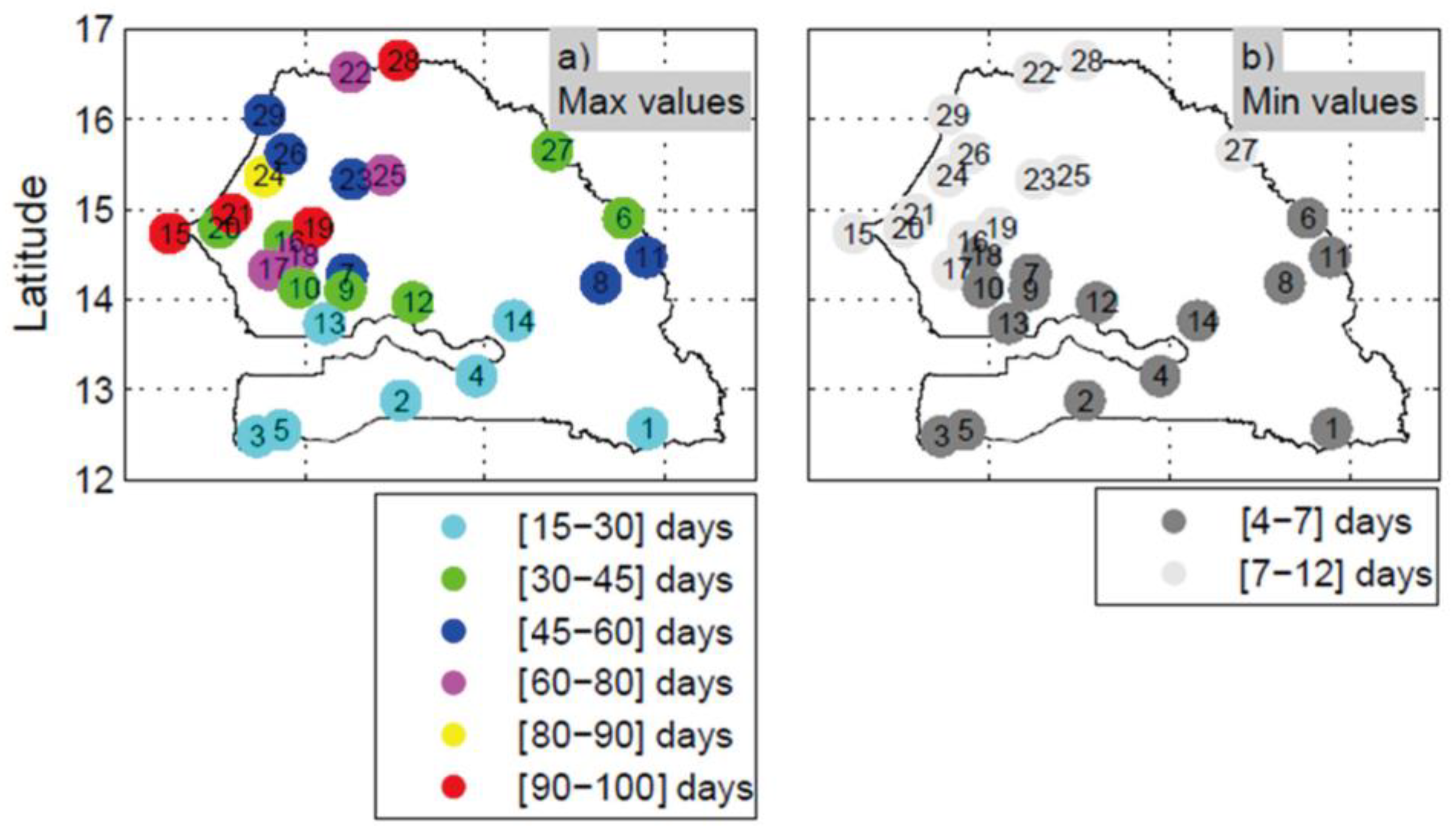

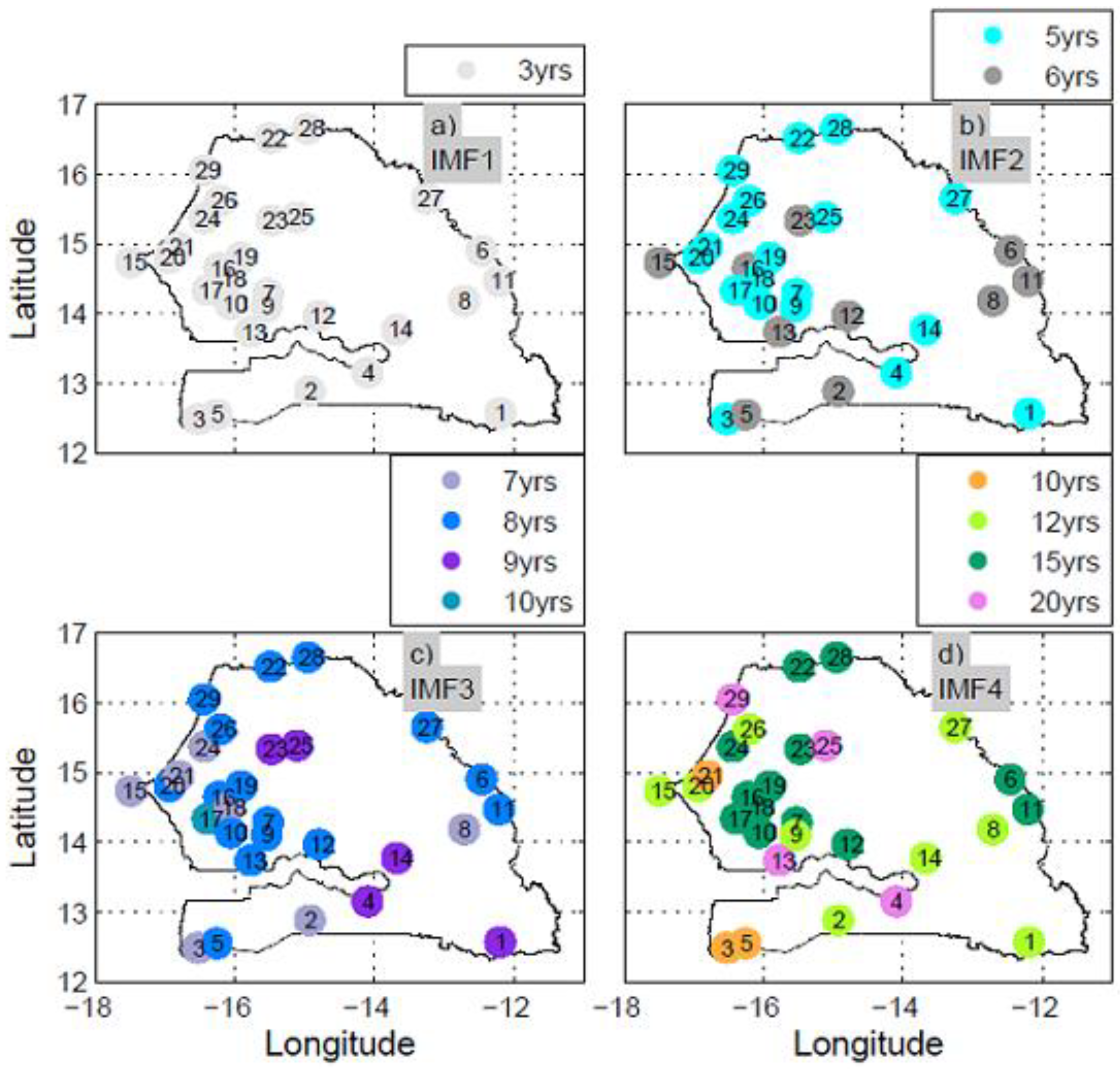
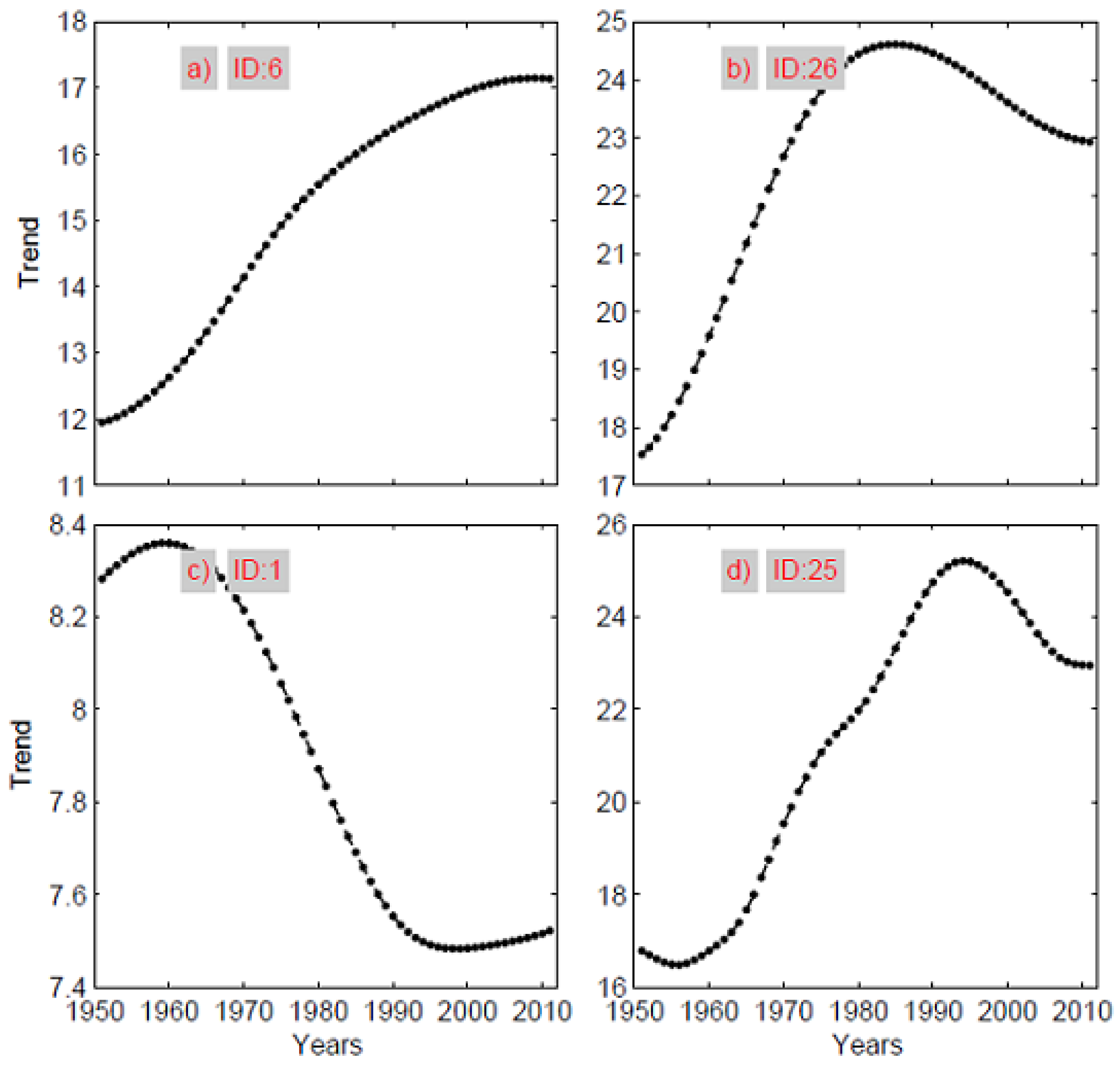

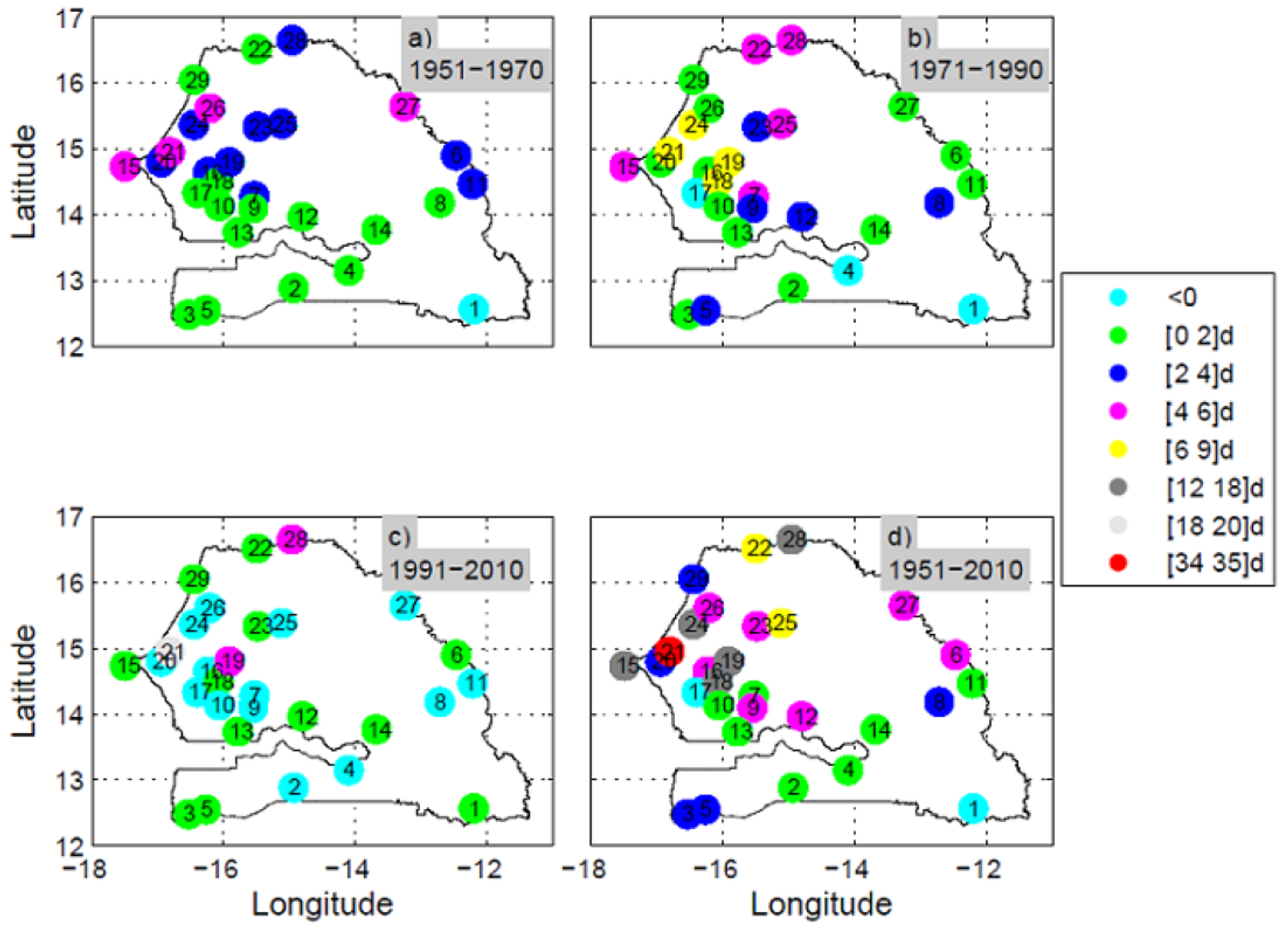

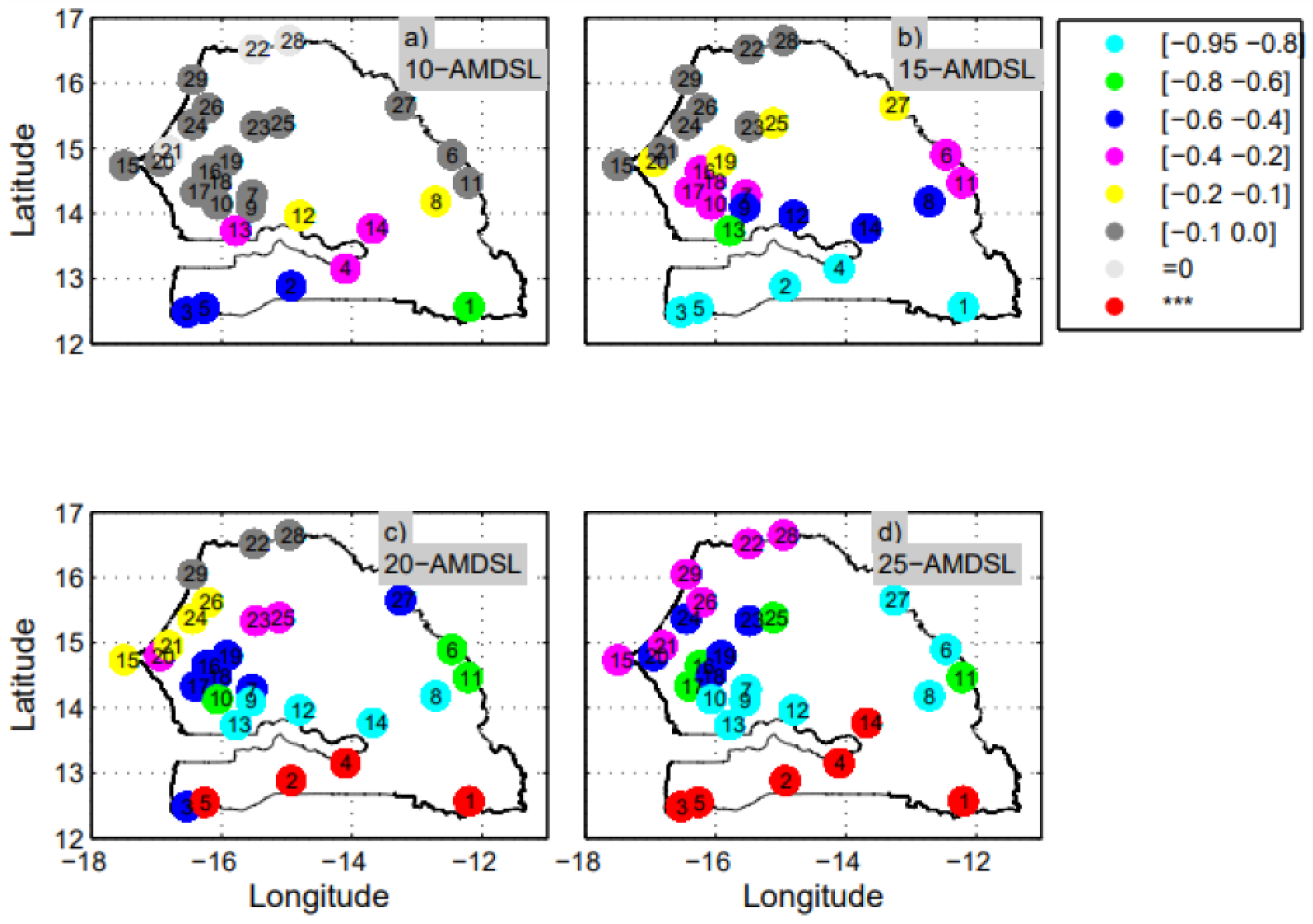
| Station ID | Station Name | Station Rainfall Zone | Lon | Lat |
|---|---|---|---|---|
| 1 | Kedougou | Southern zone (SZ) | −12.19 | 12.56 |
| 2 | Kolda | Southern zone (SZ) | −14.93 | 12.88 |
| 3 | Oussouye | Southern zone (SZ) | −16.53 | 12.48 |
| 4 | Velingara | Southern zone (SZ) | −14.10 | 13.15 |
| 5 | Ziguinchor | Southern zone (SZ) | −16.26 | 12.55 |
| 6 | Bakel | Central South zone (CS) | −12.47 | 14.9 |
| 7 | Boulel | Central South zone (CS) | −15.53 | 14.28 |
| 8 | Goudiry | Central South zone (CS) | −12.72 | 14.18 |
| 9 | Kaffrine | Central South zone (CS) | −15.55 | 14.1 |
| 10 | Kaolack | Central South zone (CS) | −16.7 | 14.13 |
| 11 | Kidira | Central South zone (CS) | −12.22 | 14.47 |
| 12 | Koungheul | Central South zone (CS) | −14.81 | 13.96 |
| 13 | Nioro | Central South zone (CS) | −15.78 | 13.73 |
| 14 | Tambacounda | Central South zone (CS) | −13.68 | 13.76 |
| 15 | Dakar | Central North zone (CN) | −17.50 | 14.73 |
| 16 | Diourbel | Central North zone (CN) | −16.23 | 14.65 |
| 17 | Fatick | Central North zone (CN) | −16.40 | 14.33 |
| 18 | Gossas | Central North zone (CN) | −16.08 | 14.50 |
| 19 | Mbacke | Central North zone (CN) | −15.92 | 14.80 |
| 20 | Thies | Central North zone (CN) | −16.95 | 14.80 |
| 21 | Tivaouane | Central North zone (CN) | −16.82 | 14.95 |
| 22 | Dagana | Northern zone (NZ) | −15.50 | 16.52 |
| 23 | Dahra | Northern zone (NZ) | −15.48 | 15.33 |
| 24 | Kebemer | Northern zone (NZ) | −16.45 | 15.37 |
| 25 | Linguere | Northern zone (NZ) | −15.12 | 15.38 |
| 26 | Louga | Northern zone (NZ) | −16.22 | 15.62 |
| 27 | Matam | Northern zone (NZ) | −13.25 | 15.65 |
| 28 | Podor | Northern zone (NZ) | −14.96 | 16.65 |
| 29 | St-Louis | Northern zone (NZ) | −16.45 | 16.05 |
| Station ID | Station Name | IMF1 | IMF2 | IMF3 | IMF4 | IMF5 | IMF6 | Trend |
|---|---|---|---|---|---|---|---|---|
| 1 | Kedougou | 69.1 * | 6.4 * | 14.6 * | 6.8 * | 0.5 | - | 2.5 |
| 2 | Kolda | 65.5 * | 11.2 * | 2.7 * | 3.6 * | 13.2 * | - | 4.0 |
| 3 | Oussouye | 72.4 * | 6.1 * | 4.6 * | 1.2 | 2.2 * | - | 13.6 |
| 4 | Velingara | 57.6 * | 18.5 * | 1.4 | 14.2 * | 5.6 * | - | 2.6 |
| 5 | Ziguinchor | 63.8 * | 3.1 * | 4.3 * | 0.8 | 2.5 * | - | 25.5 |
| 6 | Bakel | 59.3 * | 13.2 * | 2.6 * | 8.2 * | 4.5 * | - | 12.3 |
| 7 | Boulel | 61.3 * | 8.6 * | 11.2 * | 5.3 * | - | - | 13.7 |
| 8 | Goudiry | 49.9 * | 8.9 * | 15.3 * | 3.2 * | 16.6 * | - | 6.1 |
| 9 | Kaffrine | 62.3 * | 2.7 * | 13.3 * | 3.6 * | 8.9 * | - | 9.2 |
| 10 | Kaolack | 60.6 * | 1.3 | 13.8 * | 3.8 * | 18.0 * | - | 2.5 |
| 11 | Kidira | 54.9 * | 22.5 * | 3.4 * | 6.3 * | 9.6 * | - | 3.3 |
| 12 | Koungheul | 64.4 * | 9.6 * | 3.0 * | 7.5 * | 1.3 * | - | 14.3 |
| 13 | Nioro | 63.5 * | 10.1 * | 5.8 * | 11.3 * | 5.5 * | 2.7 * | 1.2 |
| 14 | Tambacounda | 67.4 * | 11.3 * | 11.3 * | 3.5 * | 2.7 * | - | 3.8 |
| 15 | Dakar | 47.8 * | 39.5 * | 1.4 * | 1.2 * | 1.2 * | - | 8.8 |
| 16 | Diourbel | 60.6 * | 20.8 * | 5.5 * | 2.6 * | 4.6 * | - | 6.1 |
| 17 | Fatick | 58.9 * | 22.5 * | 14.8 * | 2.9 * | 0.3 * | - | 0.6 |
| 18 | Gossas | 46.0 * | 4.9 * | 2.7 * | 13.1 * | 10.3 * | - | 23.0 |
| 19 | Mbacke | 47.3 * | 9.6 * | 10.2 * | 11.5 * | 2.9 * | - | 18.4 |
| 20 | Thies | 62.5 * | 10.4 * | 3.3 * | 6.1 * | 11.4 * | - | 6.5 |
| 21 | Tivaouane | 23.1 * | 26.5 * | 3.5 * | 4.7 * | 9.2 * | - | 33.0 |
| 22 | Dagana | 74.8 * | 5.4 * | 3.0 * | 5.5 * | 2.3 * | - | 8.9 |
| 23 | Dahra | 70.7 * | 4.1 * | 11.7 * | 8.2 * | 0.7 * | - | 4.7 |
| 24 | Kebemer | 47.8 * | 11.5 * | 2.8 * | 7.5 * | 8.6 * | - | 21.7 |
| 25 | Linguere | 55.1 * | 14.6 * | 7.5 * | 13.4 * | - | - | 9.4 |
| 26 | Louga | 71.4 * | 11.7 * | 4.6 * | 2.7 * | 2.40 * | - | 7.1 |
| 27 | Matam | 50.1 * | 15.2 * | 5.0 * | 5.8 * | 7.2 * | - | 16.8 |
| 28 | Podor | 52.8 * | 14.4 * | 21.9 * | 1.0 * | 1.4 * | - | 8.5 |
| 29 | St-Louis | 64.8 * | 10.8 * | 5.4 * | 8.6 * | 4.8 * | 3.8 * | 1.7 |
Disclaimer/Publisher’s Note: The statements, opinions and data contained in all publications are solely those of the individual author(s) and contributor(s) and not of MDPI and/or the editor(s). MDPI and/or the editor(s) disclaim responsibility for any injury to people or property resulting from any ideas, methods, instructions or products referred to in the content. |
© 2023 by the authors. Licensee MDPI, Basel, Switzerland. This article is an open access article distributed under the terms and conditions of the Creative Commons Attribution (CC BY) license (https://creativecommons.org/licenses/by/4.0/).
Share and Cite
Agbazo, N.M.; Tall, M.; Sylla, M.B. Nonlinear Trend and Multiscale Variability of Dry Spells in Senegal (1951–2010). Atmosphere 2023, 14, 1359. https://doi.org/10.3390/atmos14091359
Agbazo NM, Tall M, Sylla MB. Nonlinear Trend and Multiscale Variability of Dry Spells in Senegal (1951–2010). Atmosphere. 2023; 14(9):1359. https://doi.org/10.3390/atmos14091359
Chicago/Turabian StyleAgbazo, Noukpo M., Moustapha Tall, and Mouhamadou Bamba Sylla. 2023. "Nonlinear Trend and Multiscale Variability of Dry Spells in Senegal (1951–2010)" Atmosphere 14, no. 9: 1359. https://doi.org/10.3390/atmos14091359
APA StyleAgbazo, N. M., Tall, M., & Sylla, M. B. (2023). Nonlinear Trend and Multiscale Variability of Dry Spells in Senegal (1951–2010). Atmosphere, 14(9), 1359. https://doi.org/10.3390/atmos14091359









